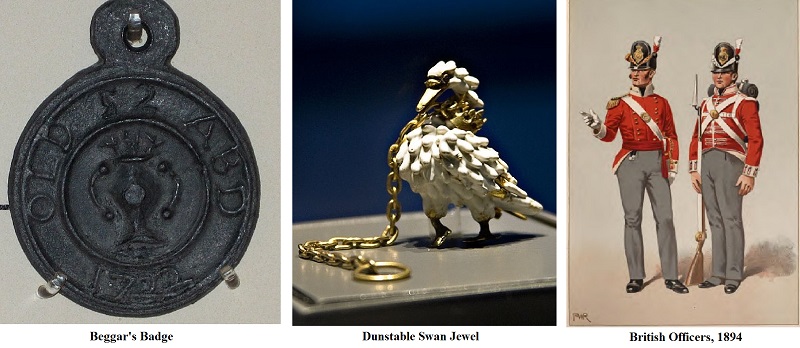
A badge is a distinctive emblem which marks an individual's office, membership or achievement. Today, we know badges mostly as the shields worn by police, firefighters and the military, but badges have been around since the Middle Ages. During that time, badges were popular as jewelry in Europe and were made of cloth or metal and worn on clothing.
In the 14th and 15th Centuries, Pilgrimage badges were popular and were given to those who had completed a pilgrimage. At this same time, Beggars badges were also commonplace. Their purpose was to identify the homeless and destitute and allow them to travel freely, collecting offerings from the church by showing their badge as proof of class.
Livery badges were also extremely popular in the 14th and 15th Centuries and were given as an indication of allegiance to an individual, family or political figure. Richard III was known to have lavishly jeweled, gold-coated badges made to give to his supporters. The Dunstable Swan Jewel is one of the most famous Livery badges. It is made of gold, has white opaque enamel covering the swan's feathers and is thought to have been made around 1400 for Henry V to give to his supporters.

Beggar's Badge: By Ray Oaks (Own work) [CC BY 3.0], via Wikimedia Commons Dunstable Swan Jewel: See page for author [CC BY-SA 3.0], via Wikimedia Commons British Officers: By Raymond Smythies, Cpt. R. H. [Public domain], via Wikimedia Commons
In the 17th Century, the British Army made cap badges a standard part of their uniform. Most European armies had badges as part of their uniform by then. By the 19th Century, badges were common among most uniforms, including school uniforms. In the 1930s, supporters of Chairman Mao Zedong began producing badges in support of the leader, the Communist Party and the Army. These badges continued to be produced and improved in quality (some were made of gold) and grew in production size over the next few decades. It is estimated that during the Chinese Cultural Revolution (1966-1971), over three billion Chairman Mao badges were made and distributed.
Today, the military, law enforcement, emergency and fire services use badges to identify themselves to the public. Badges are most commonly made of brass metal and then plated with either silver or gold. Badges are a symbol of honor, bravery and loyalty. Most uniforms require badges to be worn over the heart to symbolize the pledge taken by individuals to serve their community with pride and integrity.
